Intel's Pentium M on the Desktop - A Viable Alternative?
by Anand Lal Shimpi on February 7, 2005 4:00 PM EST- Posted in
- CPUs
Business/General Use Performance
Business Winstone 2004
Business Winstone 2004 tests the following applications in various usage scenarios:- Microsoft Access 2002
- Microsoft Excel 2002
- Microsoft FrontPage 2002
- Microsoft Outlook 2002
- Microsoft PowerPoint 2002
- Microsoft Project 2002
- Microsoft Word 2002
- Norton AntiVirus Professional Edition 2003
- WinZip 8.1
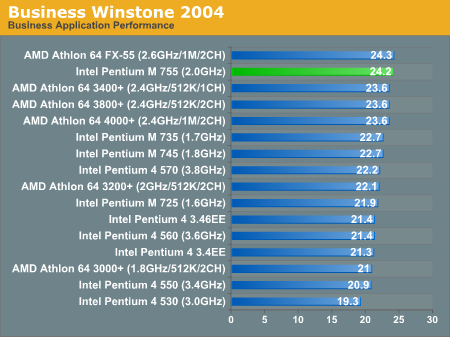
In business applications, the Pentium M does extremely well - with the 755 offering performance equivalent to that of an Athlon 64 FX-55. This is undoubtedly due to the extremely low latency L2 cache, which matters considerably in business applications.
Office Productivity SYSMark 2004
SYSMark's Office Productivity suite consists of three tests, the first of which is the Communication test. The Communication test consists of the following:"The user receives an email in Outlook 2002 that contains a collection of documents in a zip file. The user reviews his email and updates his calendar while VirusScan 7.0 scans the system. The corporate web site is viewed in Internet Explorer 6.0. Finally, Internet Explorer is used to look at samples of the web pages and documents created during the scenario."
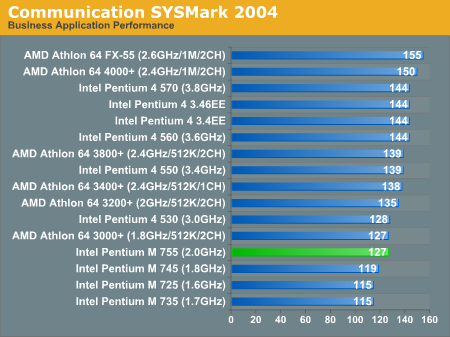
Immediately, we see that the Pentium M can't always do well, as even the 2.0GHz Pentium M 755 can't outperform the Athlon 64 3000+. The communication suite stresses memory bandwidth and latency rather than applications and usage patterns that fit into cache, so the Pentium M loses out big time.
The next test is Document Creation performance, which shows very little difference in drive performance between the contenders:
"The user edits the document using Word 2002. He transcribes an audio file into a document using Dragon NaturallySpeaking 6. Once the document has all the necessary pieces in place, the user changes it into a portable format for easy and secure distribution using Acrobat 5.0.5. The user creates a marketing presentation in PowerPoint 2002 and adds elements to a slide show template."
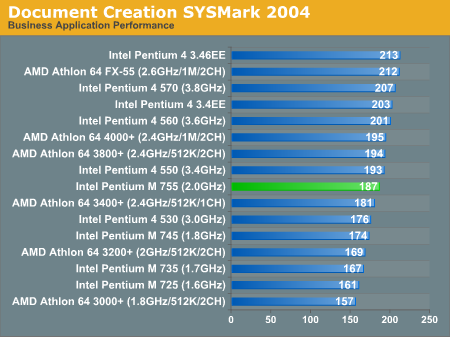
The Pentium M does a bit better in the document creation tests, as they are mostly using applications that will fit within the CPU's cache. However, the introduction of a voice recognition program into the test stresses the Pentium M's floating point performance, which does hamper its abilities here.
The final test in our Office Productivity suite is Data Analysis, which BAPCo describes as:
"The user opens a database using Access 2002 and runs some queries. A collection of documents are archived using WinZip 8.1. The queries' results are imported into a spreadsheet using Excel 2002 and are used to generate graphical charts."
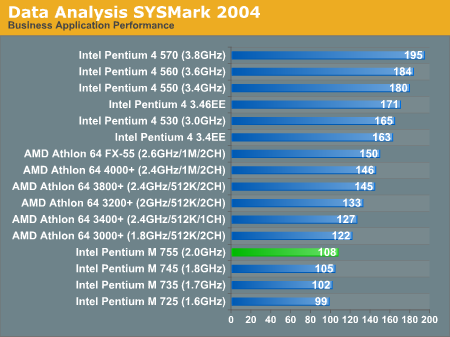
Without a doubt, the inclusion of Access usage patterns in the data analysis suite kills the Pentium M's chances here, as it once again brings up the tail in performance.
Microsoft Office XP SP-2
Here, we see in that the purest of office application tests, performance doesn't vary all too much.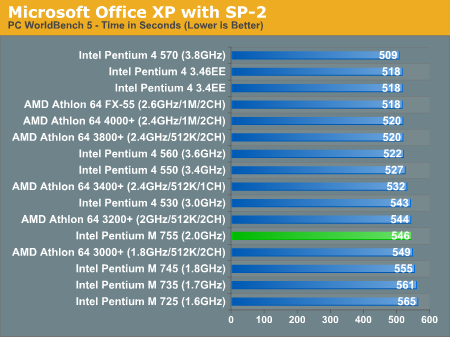
The Pentium M is competitive here, but so are all of the other CPUs.
Mozilla 1.4
Quite possibly the most frequently used application on any desktop is the one that we pay the least amount of attention when it comes to performance. While a bit older than the core that is now used in Firefox, performance in Mozilla is worth looking at as many users are switching from IE to a much more capable browser on the PC - Firefox.
The Pentium M does extremely well here, outperforming both Athlon 64 and Pentium 4 competitors. Only the higher clock speed of the Athlon 64 gives it the overall lead here.
ACD Systems ACDSee PowerPack 5.0
ACDSee is a popular image editing tool that is great for basic image editing options such as batch resizing, rotating, cropping and other such features that are too elementary to justify purchasing something as powerful as Photoshop. There are no extremely complex filters here, just pure batch image processing.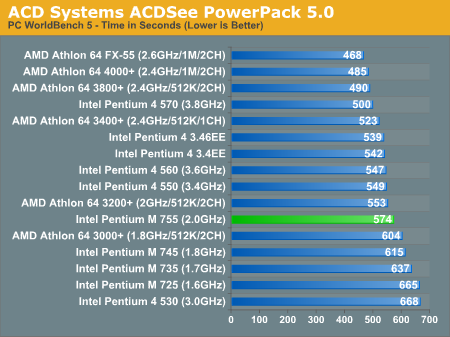
Once again, we see the Pentium M bring up the rear in situations where its low latency L2 cache can't help it.
Winzip

The Pentium M is fairly competitive in the real-world WinZip test - coming in third place overall, but the margin of victory isn't too great.
Let's look at how its peak theoretical performance is under WinRAR's built in benchmark:
WinRAR 3.40
Pulling the hard disk out of the equation, we can get a much better idea of which processors are truly best suited for file compression.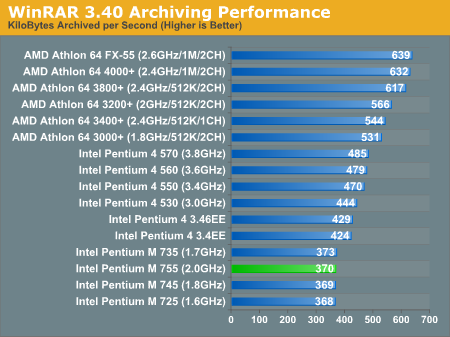
Here, we see that the lack of memory bandwidth really hurts the performance potential of the Pentium M. Luckily, most archiving tasks are usually disk-limited, so the performance differential won't be this bad in reality.










77 Comments
View All Comments
bluesdoggy - Tuesday, February 8, 2005 - link
...in the mobile world, the Pentium 4 and Athlon 64 are often castrated or limited either by low clock speeds...Mommy, is that processor a steer?
valnar - Tuesday, February 8, 2005 - link
As usual, an unfair review. Comparing a 2.0Ghz 400FSB laptop CPU against 3.0Ghz desktop heatmonsters? Of course it won't beat them. But look at how well it does, and probably would do (if reviewed correctly) against Pentium 4 2.4-2.8Ghz CPU's. Considering the ultralow power it needs and lack of heat it generates, this WILL be the hot (err... cool) ticket for Shuttle XPC's and the like in the near future. For anyone who doesn't need the fastest processor at the moment, the Banias designers did a fantastic job.EODetroit - Tuesday, February 8, 2005 - link
Great article, its about time that you did this one. And you compared both P-M motherboards on the market, I don't remember the other web sites doing that.You stated that the P-M won't scale, and that's the reason this isn't Intel's desktop future. One thing though... Intel's other desktop CPUs aren't going to scale much this year either. In fact, on a percentage basis, the P-M might actually scale more this year than the various P4-Kiln edition CPUs after all.
Combine that with a mobile-915 chipset for the desktop, and therefore the elimination of the huge memory bottlenecks (and hopefully a little more voltage adjustments) and all of the sudden we may see all those Losses and Ties turn into Ties and Wins.
Whatever happens, don't be the last enthusiast site to review the mobile-915 desktop motherboards when they arrive, like you were with this. We need a trusted source to know what to buy.
mickyb - Tuesday, February 8, 2005 - link
The performance per watt is awesome. Great for SFF. The article is good, but until there is a newer chipset for this CPU, we won't be able to determine a final performance ruling. I am dissappointed in the lack of desktop MB offerings. This will be the challenger to the MAC mini in near future. Someone will be putting laptop components in a box and call it done.I found a couple of things interesting. Taking the memory out of play, it seems the A64 is still better optimized. L1 cache of Northwood is pretty impressive. AMD has an opportunity to improve performance just by improving the L2 cache latency.
I really don't think the Pentium-M limits are around 2.6 GHz by the end of the year. At 22W, this could probably reach higher speeds. I think the upper limit that Intel is publishing is in context of a laptop and the cooling challenges in that platform. If you put a chip in a DT, then it is a different story.
AtaStrumf - Tuesday, February 8, 2005 - link
A great article! Another Anand classic :-)I'd just like you to add an Athlon XP 3200 to the lineup and at least one more Newcastle (which is just the most popular A64 at the moment ;-) May I suggest a 3000+ 2,0 GHz/512/1CH? With just one dot on the graph extrapolating anything becomes a nightmare :-(
As for P-M it's one hell of a CPU considering it's limitations and we just can't stop wondering what it could become if Intel decided to remove them. Sonoma will party answer that question, but unfortunately the ultra low voltage cap will still remain, so we may never really know.
On the other hand I think an A64 will still be a nice enough desktop CPU so we really have no need for P-M on the desktop side of things. With Lancaster-Turion supposedly on S754 we may be in for a very nice successor to 2500+ Mobile, so to hell with P-M >;-)
bob661 - Tuesday, February 8, 2005 - link
C'mon guys. These tests aren't showing that the P-M is crap, just not what we originally thought it was. I am surprised as hell at these results. For a laptop CPU, it still kicks ass. And with two A64 and three AXP machines, I am no Intel fanboy.paulsiu - Tuesday, February 8, 2005 - link
For folks who want to have a mobile chip lower power solution, why not just go to the mobile Athlon 64? The CPU performance should be about the same as their desktop counterpart (at least the socket 754 version) and you can often use the same motherboard as the desktop.The Pentium Mobile idea seems nice, but I can't imagine spending $300 on a board that contains outdated technology.
MIDIman - Tuesday, February 8, 2005 - link
Superb article.Granted, this is a "desktop" review, but I think the P-M is a completely different world from the P4-775 and A64, and I'm not entiely sure how people can compare them. This was built to be a portable solution and has been moved to desktop. Put that into account, and you have an extremely capable system that is silent, passive, and can be extremely small (matx here, but ITX is out there). I'm just trying to figure out why I didn't just read a Sonoma-based review, since it is out and being made (i.e. Dell's new 6000 laptop), or at least a 2.2ghz Dothan.
I think Sonoma will bridge a bit of this performance gap, but consdering that these types of chipsets and CPUs will always be low voltage, I think we'll always see places where its performance is maybe not up to par, but well worth every penny for small and silent with desktop performance. THey'll only get smaller and faster, and IMHO, this is pretty damn close to desktop performance.
muddocktor - Tuesday, February 8, 2005 - link
I agree withpost #36 about the benchmarks seemingly being picked to go for the P-M's weaknesses, but I guess that's how you get article hits. ;) I do fully agree that the present motherboards and chipsets they use hold back the perfromnace quite a bit; it might be a different story when the new mobile 915 chipset mATX boards come out for desktop use though.One glaring weakness in this comprehensive test though is the utter lack of numbers on system power usage and noise. If I were deploying a whole bunch of new systems for a corporation, I would give serious thought to a P-M setup even though the initial outlay would be more than a comparable P4 setup due to the decreased wattage used by the P-M system and the resultant heat from operation being much less, leading to lower environmental costs. Face it, in typical office applications the P-M is more than powerful enough for 90% of the users for the forseeable future and if your company has hundred or thousands of computers, the power saving should more than compensate for the higher pricetag of aquiring the P-M systems.
Anand, when the new mobos based on the mobile 915 chipset come out, you need to revisit Dothan and it's performance.
msva124 - Tuesday, February 8, 2005 - link
What were people expecting out of the pentium m? I have always multiplied the Mhz by 1.5 and used that number as the speed rating. So for instance the 2.0Ghz Dothan would be 3000+. The benchmarks confirm this - with the exception of one or two tests, it met or exceeded the performance of the Athlon 64 3000+.Whenever it was discussed as a desktop alternative I always assumed the implication was that this would be way off in the future, once clock speeds were ramped up.